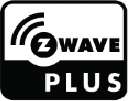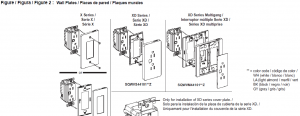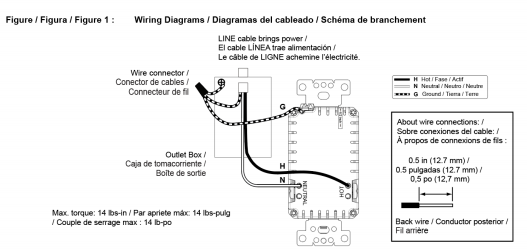
Instruction Bulletin
GDE7798100
SQR44102**Z Z-WaveTM Plus ENERGY MONITORING, TR Receptacle** = color code: WH (white), LA (light almond), BK (black), GY (gray)
Features
- Wireless Z-Wave technology creates a mesh network for command and control interoperability with other Z-Wave compliant controllers and devices.
- Tamper resistant on both outlets.
- In duplex outlets, one outlet is always on, another outlet us Z-Wave controlled.
- Z-Wave controlled outlet feature:• Manual and remote ON/OFF control of the lighting or other electrical load connected to it.• Programmable delayed OFF time.• Three configurable Power ON states.• Child lockout capability.• 3-way (multi-location) application along with Z-Wave wireless remote switch SQR50101**Z.
- Measure the energy usage of the connected loading on both outlets, display the actual consumption (in W) and the accumulated power used (in kWh) in the user interface of the gateway.
- OTA upgradable.NOTE:
- Power on state means the initial status of the device when it is powered on.
- Please refer to the user manual of SQR50101**Z for the 3-Way (multilocation) application.
- Please refer to the gateway installation manual for energy usage display and energy measurement features.
- The OTA upgrading can only complete when the loading is OFF.
|
Specification for SQR44102**Z Z-Wave TR Receptacle, Energy Monitoring, 15A 125VAC |
||
|
Voltage |
125 Vac, 60 Hz |
|
|
Regular outlet |
Current |
15A |
|
Controlled Outlet |
Incandescent |
1000 W |
|
LED |
5A |
|
|
Standard Ballast |
1200VA |
|
|
Resistive |
15A |
|
|
Motor |
½ Hp |
|
|
Operating temperature |
32–104°F (0–40°C) |
GDE7798100 © 2020 Schneider Electric All Rights Reserved
Instruction Bulletin 
|
Supply connection |
14 AWG 1 |
|
Wireless type |
Z-Wave (Support S2 and SmartStart) |
|
Wireless frequency |
908.40 MHz / 908.42 MHz / 916 MHz |
Precautions
|
|
HAZARD OF UNINTENDED USE This device is intended to be used for non-critical automation activities. It is not intended to support life, safety, or medical equipment. Failure to follow these instructions can result in personal injury or equipment damage. |
|
|
WARNING |
GDE7798100 © 2020 Schneider Electric All Rights Reserved 2
Instruction Bulletin ![]()
GDE7798100
HAZARD OF HEAT AND FIRE DAMAGERead all instructions before installation. The manufacturer will not be held responsible for product damage resulting from not following the instructions.
Failure to follow these instructions can result in death, injury or equipment damage. |
![]() WARNING: This product can expose you to chemicals including Carbon black, which is known to the State of California to cause cancer, and Bisphenol A (BPA), which is known to the State of California to cause birth defects or other reproductive harm. For more information go to www.P65Warnings.ca.gov.
WARNING: This product can expose you to chemicals including Carbon black, which is known to the State of California to cause cancer, and Bisphenol A (BPA), which is known to the State of California to cause birth defects or other reproductive harm. For more information go to www.P65Warnings.ca.gov.
Notice
Wireless Range Conditions
The wireless range is the effective distance of remote control and it will be impacted by the following conditions:
- Each wall or obstacle (e.g., refrigerator, TV, etc.) between the remote or Z-Wave device and the destination device will reduce the wireless range.
- Brick, tile, or concrete walls block more of the wireless signal than walls made of wooden studs and plasterboard (drywall).
- The angle of direction between the remote or Z-Wave device and the destination device will also impact the wireless range; normally, placing the Z-Wave devices face-to-face will get the best wireless range.
- Wall-mounted Z-Wave devices installed in metal junction boxes may suffer a significant loss of range since the metal box blocks a large part of the wireless signal.
Installation
- Turn the power OFF at circuit breaker or fuse and test that power is off before wiring.
- Wire the device according to the wiring diagram (Figure 1).Note: There’s not a wire between the Z-Wave master device and the remote switch in 3-way control using the Z-Wave remote switch SQR50101**Z, please refer to the user manual of SQR50101**Z for the wiring diagram of the remote switch itself.
- Check that all connections are tight and no bare wires exposed.
- Install the device into the standard outlet box using the screws provided.

- Install the plate (not included) (Figure 2).
- Restore power.

Operation
Figure 3: Device Features


- Local control (Figure 4):Press the program button, the appliance or device plugged into the Z-Wave controlled outlet will turn on or off.
- Group control the nodes of association group 2 (Figure 4):Press the program button twice within 1s (the interval between two pressed is less than 0.5s), the device can turn on /off the other Z-Wave devices in the same association group.NOTE: Please refer to association setting for nodes group 2 setup. This requires a gateway with advanced features and assumes the device is included in a network.
Figure 4: Local and Group Control

3. Inclusion to a Z-Wave network:NOTE: The device supports S2-authenticated and S2-unauthenticated inclusion method. It is highly recommended to only select S2-authenticated or the highest inclusion method and deselect other methods. This ensures the highest security level during Z-Wave service. During S2-authenticated inclusion, users may be asked to scan the QR code or enter a 5-digit pin code attached on the device.A. SmartStart inclusion: The feature assumes the gateway has implemented SmartStart. Users could use the APP of the gateway or the gateway camera to scan the QR code on device or on the enclosed label inside the package before powering on the device, and then when the device is powered on, it shall be automatically added to the gateway.B. Manual inclusion (Figure 5): When the gateway is in adding mode (please refer to the instruction of the Z-Wave gateway for the operations on gateway itself), press the program button 3 times within 1.5s (the interval between each press is less than 0.5s).Note: Please do not power cycle the device during the inclusion process.4. Exclusion from a Z-Wave network (Figure 5): When the gateway is in removing mode (please refer to the instruction of the Z-Wave gateway for the operations on gateway itself), press the program button 3 times within 1.5s (the interval between each press is less than 0.5s).
Figure 5: Join or Leave the Z-Wave Network

5. Remote control: After the device is included in a Z-Wave gateway, the gateway can provide control of an individual device, groups of devices and scenes, and offers flexibility in setting up the lighting control network. Please refer to the gateway instructions for details.6. Reset to factory defaults (Figure 6):Long press the reset button for >20 seconds till the blue LED blink 5 times within one second.
Figure 6: Reset to Factory Defaults

NOTE:• Use this procedure only when the Z-Wave gateway is missing or otherwise inoperable.• Reset the device to factory default settings will set the device to not in Z-Wave network state, delete the association setting and restore the configuration setting to the default.
Advanced Setting
The advanced setting requires an advanced gateway. Basic gateway does not support this setting. Users can do the setting through the interface of the advanced gateway.All configuration parameters can be restored to factory default settings by the gateway or by manual reset.
Configuration |
|||||
|
Parameter No. |
Size |
Description |
Valid Value |
Default Value |
Unit |
|
1 |
1 byte |
Synchronization of load power and LED indicator |
0 = Power ON, LED OFF Power OFF, LED ON |
1 |
N/A |
|
1 = Power ON, LED ON Power OFF, LED OFF |
|||||
|
2 |
1 byte |
Delay Off Time |
0~240 |
0 |
second |
|
3 |
1 byte |
Power On Status |
1 = Off 2 = On (full brightness) 3 = Last state |
1 |
N/A |
|
4 |
1 byte |
Child Lockout |
0= Disable 1= Enable |
0 |
N/A |
Association |
||
|
Grouping ID |
Max. No. of Nodes Description |
|
|
1 |
5 |
1. Binary Report 2. Meter Report 3. Device Reset Locally. |
|
2 |
5 |
Basic Set |
LED Indication
|
Blue LED flashing |
LED blinks slowly (once per 3 seconds) for 3 minutes: device not in network LED stays on for 1 minute: device in the network LED blinks once per second: adding/leaving network LED blinks 3 times within one second: signal for releasing the reset button LED blinks 4 times within 2 seconds: start to perform reset process LED blinks quickly (twice per second) for 5 seconds: device receive OTA command or OTA fail |
|
Blue LED on |
Device is turned on (default setting, can be configured) |
|
Blue LED off |
Device is turned off (default setting, can be configured) |
Troubleshooting
|
Issue |
Solution |
|
SmartStart inclusion taking too long |
Power cycle the device to escalate the inclusion. |
|
Inclusion is unsuccessful |
Move the gateway closer to the device and repeat the inclusion operation. |
FCC Compliance Statement
Federal Communication Commission Interference StatementThe equipment has been tested and found to comply with the limits for a class B Digital Device, pursuant to part 15 of the FCC Rules. These limits are designed to provide reasonable protection against harmful interference in a residential installation. This equipment uses, generates and can radiate radio frequency energy and, if not installed and used in accordance with the instruction, may cause harmful interference to radio communication. However, there is no guarantee that interference will not occur in a particular installation. If this equipment does cause harmful interference to radio or television reception, which can be determined by turning the equipment off and on, the user is encouraged to try to correct the interference by one or more of the following measures:-Reorient or relocate the receiving antenna.-Increase the separation between the equipment and receiver.-Connect the equipment into an outlet on a circuit different from that to which the receiver is connected.-Consult the dealer or an experienced radio/TV technician for help.
FCC Radiation Exposure Statement:This equipment complies with FCC radiation exposure limits set forth for an uncontrolled environment. This equipment should be installed and operated with minimum distance 20cm between the radiator & your body.RF Exposure: A distance of 20 cm shall be maintained between the antenna and users, and the transmitter module may not be co-located with any other transmitter or antenna.
Non-modification Statement:Any changes or modifications not expressly approved by the party responsible for compliance could void the user’s authority to operate this equipment.FCC Supplier’s Declaration of ConformityProduct Name: Z-WAVE+ 15A TR RECEPTACLEModel Number: SQR44102WHZ, SQR44102LAZ, SQR44102BKZSuppliers Name: Schneider ElectricSuppliers Address (USA): 800 Federal Street Andover, MA 01810 USASuppliers Website: www.se.com/us
FCC Compliance StatementThis device complies with part 15 of the FCC Rules. Operation is subject to the following two conditions: (1) This device may not cause harmful interference, and (2) this device must accept any interference received, including interference that may cause undesired operation.
ISED StatementThis Class [B] digital apparatus complies with Canadian CAN ICES-003(B).Cet appareil numérique de la classe [B] est conforme à la norme NMB-003(B)du Canada.This device contains licence-exempt transmitter(s)/receiver(s) that comply with Innovation, Science and Economic Development Canada’s licence-exempt RSS(s). Operation is subject to the following two conditions:1. This device may not cause interference.2. This device must accept any interference, including interference that may cause undesired operation of the device.This equipment complies with ISED RSS-102 radiation exposure limits set forth for an uncontrolled environment. This equipment should be installed and operated with a minimum distance of 20cm between the radiator and any part of your body. PModel number: SQR44102WHZ, SQR44102LAZ, SQR44102BKZ
Warranty InformationSchneider Electric warranties its products to be free of defects in materials and workmanship for a period of two (2) years. There are no obligations or liabilities on the part of Schneider Electric for consequential damages arising out of or in connection with the use or performance of this product or other indirect damages with respect to loss of property, revenue, or profit, or cost of removal, installation, or reinstallation.
References
[xyz-ips snippet=”download-snippet”]


